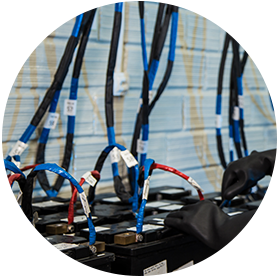Energy Accumulation Systems
Back | Technical Report published on 09/29/2015
Energy Accumulation Systems
The demand for energy is growing. Increasingly, the availability of more sources is necessary, whether generated from primary resources, such as coal, oil, natural gas and uranium, or from alternative sources, such as wind, sun or biomass. The increase in the percentage of participation in the latter depends largely on ability to transport and store this generated energy, as these have low energy density and are produced sparsely and intermittently.
In this context, there are electrochemical energy stores, also called secondary batteries or simply batteries. The basic principle of these devices is chemical energy storage, which can be made available for use through electrochemical reactions, and are defined as chemical reactions where electrons transport is made at a distance greater than the order of the size of the atoms. In essence, the flow of electrons (electricity) generated by the reactions can be harnessed to generate electrical current.
There are several technologies and electrochemical systems used for these activities, the main ones currently being those of lead-acid, lithium, nickel-metal hydride and nickel-cadmium. There are many others, but in this text, due to space, we will discuss some aspects related to lead-acid technology, since, in addition to being most commonly used, it is very versatile, safe and environmentally friendly, because there is a very well established recycling network for the materials it contains.
Lead-acid batteries, although they have more than 100 years of history, are far from being something of the past. What is revealed is an electrochemical system that is renewed and is increasingly more prepared to meet current expectations. This fact can be seen if we look at the wide variety of applications where it is found. In cars, the battery is used to generate a pulse of very large electric current, which is used to initiate the internal combustion engine. Due to the presence of the alternator, the battery is recharged during vehicle operation so that there is a high state of charge most of the time. Another application is to provide power for traction, i.e., to effectively serve as the engine. Some of the applications are to provide energy for pallet trucks and forklifts. Thus we have the traction batteries, operating in a regime of deeper discharge and are recharged in hours, being governed by cycles of use (discharge), recharge and rest.
Recently, with the development of hybrid vehicles, a new type of system arises: the partial charge condition. This system is used due to various technical details, but the essence is the use of regenerative braking, which aims to recover braking energy to recharge the battery. Thus, one can have a hybrid propulsion system, now operating from an internal combustion engine, either aiding or even being moved by an electric motor, driven by the energy released by the battery.
This scheme is characterized by the condition of the accumulator, which maintains a charge of around 50% of the total, which means that it is capable of retaining the braking energy without suffering from overload..
The major challenges for hybrid vehicle batteries are to develop electrochemical systems that have high charge acceptance, i.e., with high ability to receive energy-efficient regenerative braking, which is an energy to be absorbed in a short time, a situation which is called HRPSOC (high rate partial state of charge). Moreover, it must be able to withstand a large number of cycles and a reduced production cost, so that it is possible, in the near future, to popularize this technology, including for popular cars.


